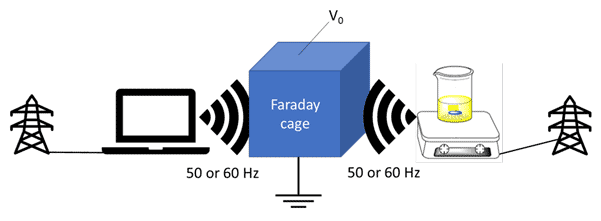In recent years, the popularity of Faraday enclosures among preppers has increased, driven by an growing awareness of possible EM threats and the necessity for dependable protection of electronics. These innovative structures, designed to block electromagnetic fields, have turned into essential tools for those looking to safeguard their devices from a range of threats, such as solar flares, EMP, and even everyday interference. For https://ramseytest.com , a Faraday cage is more than a precaution; it’s a critical component of their preparedness plan.
As the dependence on technology in daily life continues to increase, grasping the importance and role of Faraday cages has turned out to be essential. Whether you’re a novice to prepping or are an seasoned enthusiast, understanding what to look for in a Faraday cage can make all the difference. From the materials used to the size and portability options, choosing the appropriate cage is key to keeping your devices stay safe and protected in unpredictable scenarios. This article will explore the key characteristics and factors that every prepper should keep in mind when selecting a Faraday cage, aiding you to make informed decisions for your tech devices and preparedness strategies.
Key Features of Faraday Cages
Faraday enclosures are engineered to provide efficient shielding against EM waves, making them crucial for defending vulnerable equipment. One of the primary features to consider is the substance used in the building of the cage. Metals such as brass, tin, and nickel are outstanding choices due to their ability to conduct electricity, which allows them to bounce back and absorb electromagnetic waves. The gauge of the metal also plays a vital role; more robust materials commonly offer superior protection but can add to the burden and cost.
Another notable feature is the structure of the cage itself. A carefully built Faraday cage should have limited openings since gaps can weaken its protective effectiveness. Netted cages can be helpful for portability but must be made with tight enough mesh to impede elevated frequency signals. In contrast, solid cages are commonly more successful but can be more cumbersome. Additionally, the cage should have a secure seal to stop any electronic escape, securing that the contents remain protected.
Dimensions is a crucial consideration when picking a Faraday cage, as it needs to fit all planned devices comfortably. A cage that is too tight may not provide adequate protection, while one that is excessively big can be awkward to carry. It's essential to assess the measurements based on what equipment will be stored in and the likely situations in which the cage will be utilized. By emphasizing on substance, structure, and size, preppers can choose an efficient Faraday cage customized to their individual requirements.
Components and Building
The effectiveness of a Faraday enclosure largely is determined by the materials used in its construction. Typical options include copper, aluminium, and metal, each providing different degrees of conductivity and shielding abilities. Copper is recognized for its high electrical conductivity, making it an ideal choice for optimizing signal attenuation. Aluminium is less heavy and frequently more cost-effective, providing a good balance of efficiency and cost. Steel, while heavier and less efficient than Cu, offers durability and can be efficient in blocking lower frequency waves.
When considering construction, pay close attention to the gauge of the substances. Thicker materials commonly provide better shielding from EMI, but they can also add weight and bulk. Mesh designs can be viable options, as they allow for lightweight designs while still providing adequate shielding if the mesh size is suitable. The building technique, including bonding or joining joints, can also impact the integrity and efficacy of the Faraday enclosure. Making sure tight seams and connections is essential for preventing unintentional openings that could jeopardize the cage's protective qualities.
In addition to the substances and gauge, the overall design and construction of the Faraday cage play significant roles in its performance. Elements such as the internal layout, grounding techniques, and even the inclusion of insulation can influence how well the cage functions. A properly planned cage will not only shield against EM radiation but also ensure that stored items are safe and shielded from physical damage. Evaluating all these factors will help you choose or construct a Faraday cage that meets your specific requirements efficiently.
Testing and Performance
When it comes to confirming that a Faraday cage provides the safeguard it claims, assessing its effectiveness is crucial. There are several methods to assess how well a cage blocks electromagnetic signals. One frequent method is to use a radio frequency (RF) meter to evaluate signal strength inside the cage compared to the outside. By positioning a device that broadcasts signals near the cage and tracking the reception inside, users can determine the level of shielding obtained. If signals are still perceptible inside, it may suggest that the cage needs improvements or is not built to specifications.

Another critical aspect of assessing a Faraday cage is to inspect for any physical leaks that could diminish its shielding capabilities. This requires checking gaps, seams, or areas where the conductive material may not be continuous. Conductive materials must fully encase the electronics inside without breaks, as even small openings can let electromagnetic interference penetrate. Users should also factor in assessing with multiple types of frequencies, including those used by cell phones, radios, and Wi-Fi, to ensure comprehensive protection across the spectrum.
Ultimately, the efficacy of a Faraday cage will also rely on grasping its design and construction quality. Factors such as the material used, the thickness of the metal, and the overall build can greatly influence performance. By investing time in thorough testing, individuals can confirm that their Faraday cage is not only a dependable safeguard against EMPs but also a strong solution for various electronic protection needs.
